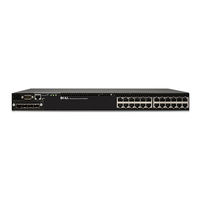Dell PowerConnect FCX648-S Manuals
Manuals and User Guides for Dell PowerConnect FCX648-S. We have 3 Dell PowerConnect FCX648-S manuals available for free PDF download: Configuration Manual, Getting Started Manual, User Manual
Dell PowerConnect FCX648-S Configuration Manual (1494 pages)
PowerConnect B-SERIES FCX
Table of Contents
-
-
-
-
Parameters61
-
-
Devices82
-
-
-
Overview99
-
Image File Types103
-
Rebooting106
-
-
-
-
-
Licensing Rules123
-
-
-
-
A Data Port157
-
-
Stacking Mode167
-
Stack Mismatches196
-
Image Mismatches196
-
-
Supported Events205
-
Failover208
-
And Stack Split211
-
-
-
-
Ipv6 Addressing240
-
-
Ipv6 Debug242
-
Ipv6 Logging243
-
Ipv6 Ping244
-
SNTP over Ipv6245
-
SNMP3 over Ipv6245
-
Ipv6 Telnet246
-
Ipv6 Traceroute247
-
-
STP Overview249
-
-
Fast Port Span265
-
Fast Uplink Span267
-
W Draft 3307
-
-
BPDU Guard324
-
Root Guard326
-
-
-
-
-
Command Syntax362
-
-
Topology Groups375
-
-
Configuring MRP391
-
MRP CLI Example397
-
-
-
UDLD Overview425
-
Enabling UDLD427
-
-
-
-
Port Priority459
-
-
CLI Syntax467
-
-
-
VLAN Overview469
-
Types of Vlans469
-
Default VLAN475
-
Q Tagging476
-
-
-
-
-
GVRP Overview547
-
VLAN Names550
-
Configuring GVRP552
-
CLI Examples564
-
-
-
-
ACL Overview590
-
Types of IP Acls590
-
-
Membership615
-
ACL Statistics624
-
-
-
Classification633
-
Qos Queues638
-
Marking641
-
Scheduling645
-
-
-
-
Over the Limit659
-
-
Configuring RIP668
-
Enabling RIP669
-
-
Overview675
-
Command Syntax677
-
-
-
-
-
LLDP Overview726
-
Benefits of LLDP727
-
-
-
LLDP-MED Class729
-
-
Operating Modes729
-
LLDP Packets730
-
TLV Support731
-
MIB Support734
-
Syslog Messages734
-
-
-
Configuring LLDP734
-
-
Multicast Terms771
-
PIM Dense775
-
PIM Sparse784
-
And Statistics792
-
PIM Passive804
-
-
IGMP Proxy820
-
-
CLI Commands823
Advertisement
Dell PowerConnect FCX648-S Getting Started Manual (260 pages)
PowerConnect B-Series FCX; PowerConnect B-Series FCXS
Table of Contents
-
English
5-
Features7
-
Français
67-
Introduction67
-
-
Deutsch
89-
Funktionen91
Dell PowerConnect FCX648-S User Manual (152 pages)
Web Management Interface User Guide
Table of Contents
-
-
-
-
Configuring VLAN122
-
Configuring STP130
-
Configuring RSTP135
Advertisement
Advertisement


